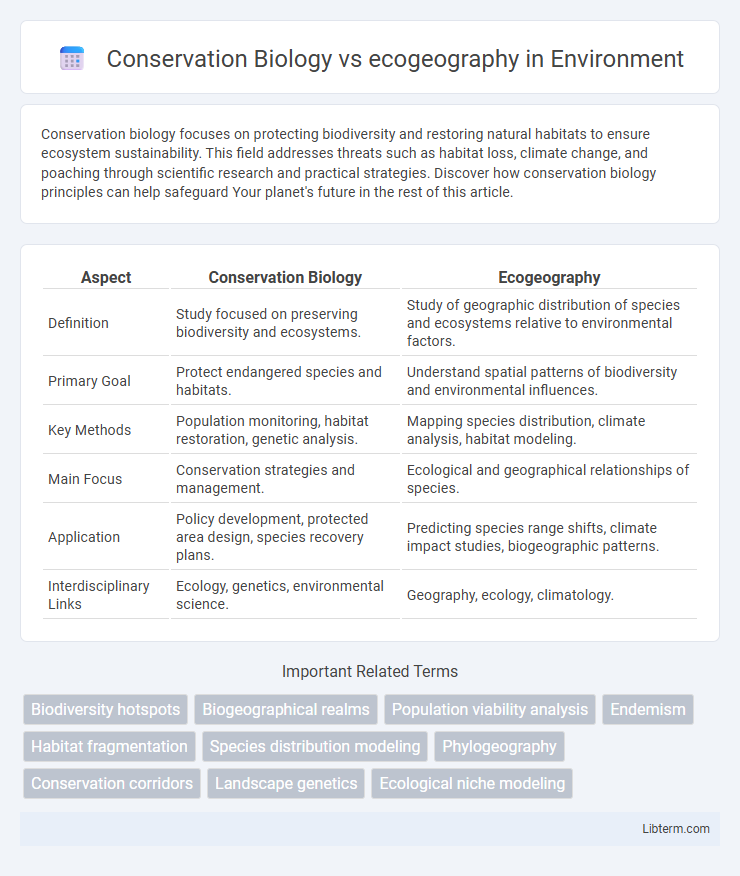Conservation biology focuses on protecting biodiversity and restoring natural habitats to ensure ecosystem sustainability. This field addresses threats such as habitat loss, climate change, and poaching through scientific research and practical strategies. Discover how conservation biology principles can help safeguard Your planet's future in the rest of this article.
Table of Comparison
| Aspect | Conservation Biology | Ecogeography |
|---|---|---|
| Definition | Study focused on preserving biodiversity and ecosystems. | Study of geographic distribution of species and ecosystems relative to environmental factors. |
| Primary Goal | Protect endangered species and habitats. | Understand spatial patterns of biodiversity and environmental influences. |
| Key Methods | Population monitoring, habitat restoration, genetic analysis. | Mapping species distribution, climate analysis, habitat modeling. |
| Main Focus | Conservation strategies and management. | Ecological and geographical relationships of species. |
| Application | Policy development, protected area design, species recovery plans. | Predicting species range shifts, climate impact studies, biogeographic patterns. |
| Interdisciplinary Links | Ecology, genetics, environmental science. | Geography, ecology, climatology. |
Introduction to Conservation Biology and Ecogeography
Conservation Biology focuses on preserving biodiversity by studying species, habitats, and ecosystems at risk due to human activities and environmental changes. Ecogeography examines the spatial distribution of ecosystems and species in relation to environmental factors, providing critical insights for habitat conservation and species management. Integrating principles from both fields enhances strategies for protecting endangered species and maintaining ecological balance across landscapes.
Defining Conservation Biology: Scope and Significance
Conservation biology is an interdisciplinary scientific field dedicated to understanding and preserving biodiversity, focusing on species, habitats, and ecosystems threatened by human activities and environmental changes. It encompasses genetic, species, and ecosystem-level conservation, emphasizing the maintenance of ecological processes and resilience to promote long-term sustainability. The scope of conservation biology integrates ecological theory, evolutionary biology, and social science to inform practical strategies for habitat restoration, endangered species protection, and biodiversity management worldwide.
Understanding Ecogeography: Concept and Applications
Ecogeography examines the spatial distribution of ecosystems and species in relation to environmental factors such as climate, soil, and topography, providing critical data for biodiversity assessments. Conservation biology integrates ecogeographic insights to develop targeted strategies for habitat protection, species preservation, and ecosystem management. Utilizing geospatial analysis and ecological modeling, ecogeography helps identify areas of high conservation priority and informs sustainable land-use planning.
Historical Development of Both Fields
Conservation biology emerged in the 1980s as a multidisciplinary science aimed at preventing species extinction and habitat loss, rooted in growing environmental concerns and biodiversity crises. Ecogeography, dating back to the early 20th century, combines ecological principles with geographical distribution patterns to explain species' spatial variability and adaptation. Both fields evolved through landmark research linking species distributions to environmental factors, shaping modern strategies in biodiversity conservation and habitat management.
Core Objectives: Conservation Biology vs Ecogeography
Conservation Biology aims to preserve biodiversity by understanding species extinction processes, habitat loss, and ecosystem function, focusing on practical strategies to protect endangered species and restore habitats. Ecogeography studies the spatial distribution of organisms in relation to environmental factors, emphasizing patterns of biodiversity and the effects of climate, topography, and land use on species distribution. The core objective of Conservation Biology centers on species and ecosystem preservation, while Ecogeography prioritizes mapping and analyzing biogeographical patterns to inform conservation planning.
Key Methods and Tools in Each Discipline
Conservation biology employs population viability analysis, habitat modeling, and genetic diversity assessments using tools such as GIS, remote sensing, and molecular markers to monitor species and ecosystem health. Ecogeography focuses on spatial distribution and environmental relationships through climate modeling, species distribution models (SDMs), and biogeographic mapping, often utilizing GIS and ecological niche modeling. Both disciplines integrate spatial analysis but apply distinct methods tailored to conservation management and the understanding of ecological patterns across landscapes.
Interdisciplinary Connections and Overlaps
Conservation Biology and Ecogeography intersect through their shared focus on biodiversity patterns and habitat preservation, integrating ecological principles with geographic data analysis. Spatial distribution models from ecogeography enhance conservation strategies by identifying critical habitats and predicting species responses to environmental changes. Collaborative approaches utilize GIS technologies and ecological metrics to address species conservation challenges within landscape and climate contexts.
Real-world Case Studies: Conservation and Ecogeography in Action
Real-world case studies in conservation biology and ecogeography demonstrate the practical integration of species distribution modeling with habitat preservation strategies to combat biodiversity loss. For example, the reintroduction of the Iberian lynx in Spain utilizes ecogeographical data to identify optimal habitats, enhancing survival rates and genetic diversity. These interdisciplinary approaches optimize resource allocation and policy-making to restore endangered ecosystems and maintain ecological balance.
Challenges and Emerging Trends in Both Fields
Conservation biology faces challenges like habitat fragmentation, climate change impacts, and genetic diversity loss, while ecogeography tackles issues related to species distribution shifts influenced by environmental gradients and global warming. Emerging trends in conservation biology include integrating genomics and remote sensing technologies to enhance species monitoring, whereas ecogeography increasingly utilizes spatial modeling and machine learning to predict biodiversity patterns under changing climates. Both fields are converging through interdisciplinary approaches that combine ecological data with geographic information systems (GIS) to address complex conservation and biogeographical questions.
Future Directions and Integrative Approaches
Conservation biology increasingly integrates ecogeography to enhance spatial analysis of biodiversity and habitat patterns, enabling predictive modeling under climate change scenarios. Future directions emphasize the use of advanced Geographic Information Systems (GIS) and remote sensing technologies to monitor species distributions and ecosystem health in real time. Interdisciplinary approaches combining genetics, ecology, and spatial data science are critical for developing adaptive conservation strategies that address habitat fragmentation and global biodiversity loss.
Conservation Biology Infographic

 libterm.com
libterm.com